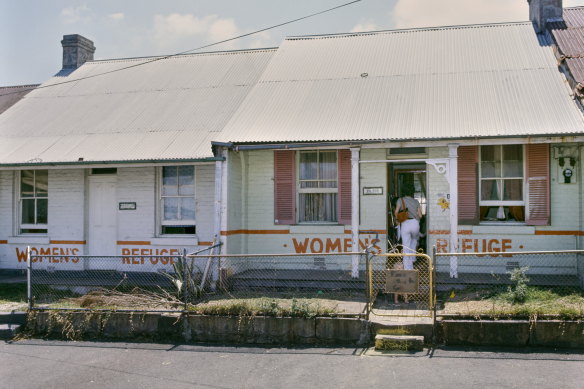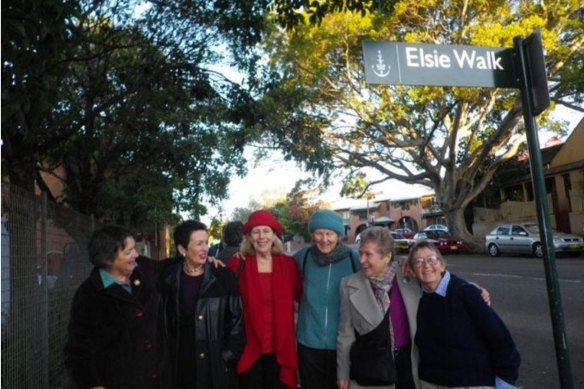By Mary Ward
On March 8, 1974, women’s liberationists took to the streets of Glebe, climbing onto rooftops in an International Women’s Day protest.
The next week, some of the group broke into one of the inner-Sydney suburb’s many rundown vacant terraces. They changed the locks and painted two words across the front: women’s refuge.
But while the idea of a women’s refuge was radical in itself – the Family Law Act was more than a year away – the group of women leading the charge to establish one, including author Dr Anne Summers, North Sydney mayor Carole Baker and the late economist Margaret Power, had spent months seeking premises through much less radical means.

Elsie Women’s Refuge.Credit: National Archives of Australia
There had been talks with developers, and even some offered, but nothing was remotely suitable, Summers recalled.
It was a television program on the Anglican Church’s planned sale of Glebe terraces to the federal government which gave the academic, then working on her first book, an idea.
“I knew there were these vacant houses in Glebe, so I basically just went on a walk,” she said.
“I noticed this house on Westmoreland Street. I looked into the windows and went around the back and it looked usable. But best of all, it had a woman’s name: Elsie.”
The feminist squatters attracted the attention of the media, and local shops donated food and whitegoods to the new Elsie Women’s Refuge, which opened 50 years ago this week.
Once women and their children started arriving, the group learnt some hard lessons early on. Safety was a concern – one night a man turned up with a gun, looking for his ex – and allowing alcohol and drugs was incompatible with having a safe environment for children. They also realised they would need to operate 24 hours, and provide childcare. Women who had been taken in returned as volunteers, but they couldn’t run a service on charity alone.
“We had no money at all,” said Summers. “And in some ways you could say it was irresponsible of us, but it felt most important for us to start something and hope that the money would follow.”
Hours away in Canberra, feminist author Sara Dowse was a public servant who had just been appointed the inaugural head of the federal Office of Women’s Affairs. While some women’s initiatives such as childcare had been pushed by politicians, Dowse said the refuge movement was different.
“The refuge movement was much more ground up,” she said, describing them as “seat of their pants” operation at a time when the very idea of domestic violence was embryonic.

Elsie pioneers at the Glebe laneway christened in honour of the refuge and its legacy. (From left) Annie Bickford, Lord Mayor of Sydney Clover Moore, Anne Summers, Margaret Power, Jozefa Sobski and Sue Wills.
The Whitlam government, which now owned the Glebe terraces, granted Elsie a lease. By the end of 1975 there were 13 refuges across Australia.
A single mother who had found herself in the public service via the women’s movement, Dowse said she was surprised by the openness of “men in suits” to fund the refuges, particularly after Whitlam’s dismissal.
“Nineteen seventy-seven was a slashing budget, and plenty of allocations [for social services] were cut by half. But the money for refuges doubled,” she recalled.
This week, domestic violence service operators, academic and policy leaders will meet at UTS Sydney for an inaugural Elsie Conference, chaired by Summers.
Speakers include former governor-general Quentin Bryce, former High Court justice Virginia Bell and eSafety Commissioner Julie Inman Grant, as well as women who spent time living and working at Elsie.
Summers said the conference would reflect on the past, but also discuss present-day concerns, noting that while new issues – such as technology-based abuse – had emerged, housing remained a key issue.
“It’s always been difficult to find housing for a refuge, but now people are being put up in motels for months on end,” she said.
For Delia Donovan, CEO of Domestic Violence NSW, Elsie is also the genesis of her organisation, which now represents more than 170 services.
“This anniversary is about recognising the shoulders we are standing on,” she said.
“As women today, we are still trying to dismantle the powers set by patriarchy, working in that negative equity system these women encountered.”
After moving premises, Elsie’s management was handed over to St Vincent de Paul in 2014. Today, services continue to feel the impacts of the sell-offs and funding cuts experienced that year, said Donovan.
According to the Australian Institute of Health and Welfare’s Specialist Homelessness Services report, there was a 25 per cent increase in presentation to services in 2022-23 compared to the previous year.
Domestic Violence NSW is seeking a 20 per cent baseline funding increase for all specialist sexual, domestic and family services in the upcoming state budget.
“We often get the odd [funding] announcement, which is great, but we have never seen it meet demand,” said Donovan, calling for a statewide analysis of gaps in the system to inform ongoing funding.